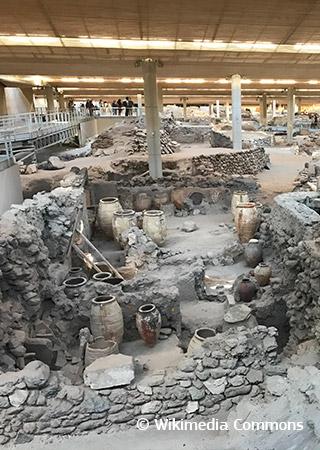
Fava Santorinis PDO is obtained from the seeds of Lathyrus clymenum L., a flowering plant grown as a crop on eight of the Cyclades islands in the South Aegean Sea. From sowing to packaging, every step of production takes place on the islands, using local methods that stretch back over millennia.
The final product assumes the form of small golden discs; when cooked, they take on a sweet taste velvety texture, perfect as a light base for a variety of dishes or as a tasty side dip.
Origins
The name ‘fava’ first appears in fragments of a lost tragedy by Aeschylus, dating from the 6th-5th century B.C.
However, the history of Fava Santorinis PDO can be traced back a further 1,000 years, to a historical event of seismic significance.
In the 16th century BC, one of the largest volcanic eruptions ever recorded took place on the island of Santorini. The eruption decimated the island’s geography and forced local populations to flee. One of the largest settlements to be abandoned was the Minoan town of Akrotiri, which was covered in layers of ash and volcanic dust.
Thousands of years later, excavations revealed that much of the town had been preserved. Amongst the numerous artworks and artefacts uncovered, archaeologists discovered the remains of seeds, which were identified as belonging to the Lathyrus clymenum L. plant. Evidence showed that the plant had been harvested and the seeds milled for consumption.
When people returned to the island in the years after the eruption, they resumed the practice of cultivating Lathyrus clymenum L., one of the few crops that could thrive in the volcanic soil.
Having survived the eruption, the production of Fava Santorinis also survived the test of time, becoming a staple crop for the islanders and a much-loved dish beyond its shores.
In 2010, the unique heritage of Fava Santorinis was recognised by the European Union when the product was awarded the status of a protected designation of origin (PDO).
Production
Fava Santorinis PDO is made from the seeds of Lathyrus clymenum L., a twining plant that flowers in crimson petals, with touches of violet or lilac. The plant grows widely and wildly across the Mediterranean, but is only cultivated as a crop on a small group of islands in the South Aegean Sea.
Lying in the Cyclades region, these islands comprise of Santorini (also known as Thira) and seven surrounding islets: Thirasia, Palea Kameni, Nea Kameni, Aspro (Aspronisi), Christiani and Askania in the Cyclades.
The islands are bathed in sunshine, typically stretching to over 200 days per year, and buffeted by the dry northerly winds of the Aegean Sea, known as meltemia.
The twining body of Lathyrus clymenum L. clings to surfaces, helping it to withstand the meltemia. As a xerophilous plant, it can survive in the arid, almost desert-like conditions of the islands. With minimal to non-existent land water resources, the plant absorbs water from the humid sea air through osmosis, a process that gives the plant its high sugar content.
Similarly, the plant has the ability to retain atmospheric nitrogen, thereby coping with the islands’ volcanic soil, which is laden with deposits of pumice and lava but lacks both organic matter and basic inorganic nutrients, such as potassium or nitrogen.
Expertise has evolved over millennia to guarantee a stable crop in the face of these challenging environmental conditions. The peas are processed according to traditional methods, with most stages of production still done by hand.
Sowing traditionally takes place in mid-winter, with some growers still observing the custom of planting their first seeds on the 21 December, the winter solstice.
Once sown, the crop must be expertly nurtured and monitored until it is ready to harvest.
The harvested seeds are then dried in the Aegean sun, before being placed in stores dug out of volcanic rock. Known as kanaves, these stores provide the perfect conditions for the seeds to age, protecting them from pests and keeping them sufficiently hard to withstand the milling process.
Milling takes place in stone grinding mills, where the husks are removed and the seeds are separated from the cotyledons.
The resulting flattened yellow discs are swiftly packaged, in order to prevent damage from humidity, pests, and diseases.
More information
Fava Santorinis PDO – legal specifications





